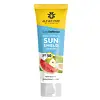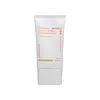What's inside
What's inside
 Key Ingredients
Key Ingredients

 Benefits
Benefits

 Concerns
Concerns

 Ingredients Side-by-side
Ingredients Side-by-side

Water
Skin ConditioningCocos Nucifera Oil
MaskingTitanium Dioxide
Cosmetic ColorantCetyl Alcohol
EmollientCocos Nucifera Water
MaskingCitrullus Lanatus Fruit Extract
Skin ConditioningGlyceryl Stearate
EmollientGlycerin
HumectantAloe Barbadensis Leaf Juice
Skin ConditioningPropanediol
SolventEthylhexyl Methoxycinnamate
UV AbsorberButyl Methoxydibenzoylmethane
UV AbsorberButylene Glycol
HumectantParfum
MaskingPunica Granatum Extract
AstringentCentella Asiatica Extract
CleansingAcrylates/C10-30 Alkyl Acrylate Crosspolymer
Emulsion StabilisingOctocrylene
UV AbsorberPhenoxyethanol
PreservativeChlorphenesin
AntimicrobialButyrospermum Parkii Butter
Skin ConditioningAllantoin
Skin ConditioningLecithin
EmollientStearic Acid
CleansingWater, Cocos Nucifera Oil, Titanium Dioxide, Cetyl Alcohol, Cocos Nucifera Water, Citrullus Lanatus Fruit Extract, Glyceryl Stearate, Glycerin, Aloe Barbadensis Leaf Juice, Propanediol, Ethylhexyl Methoxycinnamate, Butyl Methoxydibenzoylmethane, Butylene Glycol, Parfum, Punica Granatum Extract, Centella Asiatica Extract, Acrylates/C10-30 Alkyl Acrylate Crosspolymer, Octocrylene, Phenoxyethanol, Chlorphenesin, Butyrospermum Parkii Butter, Allantoin, Lecithin, Stearic Acid
Water
Skin ConditioningZinc Oxide
Cosmetic ColorantPropylheptyl Caprylate
EmollientDibutyl Adipate
EmollientButylene Glycol
HumectantDisiloxane
Skin ConditioningCyclohexasiloxane
EmollientPolyglyceryl-5 Polyricinoleate
EmulsifyingPolymethylsilsesquioxane
Glycerin
HumectantBis-Ethylhexyloxyphenol Methoxyphenyl Triazine
Skin ConditioningCaprylyl Methicone
Skin ConditioningDicaprylyl Ether
EmollientDiethylamino Hydroxybenzoyl Hexyl Benzoate
UV FilterEthylhexyl Triazone
UV AbsorberTitanium Dioxide
Cosmetic ColorantDisteardimonium Hectorite
StabilisingMagnesium Sulfate
Calcium Aluminum Borosilicate
Triethoxycaprylylsilane
1,2-Hexanediol
Skin ConditioningPolyglyceryl-3 Polydimethylsiloxyethyl Dimethicone
Skin ConditioningParfum
MaskingVinyl Dimethicone/Methicone Silsesquioxane Crosspolymer
Caprylyl Glycol
EmollientGlyceryl Caprylate
EmollientEthylhexylglycerin
Skin ConditioningTocopherol
AntioxidantBiosaccharide Gum-1
HumectantOryza Sativa Bran Oil
EmollientBeta-Glucan
Skin ConditioningWater, Zinc Oxide, Propylheptyl Caprylate, Dibutyl Adipate, Butylene Glycol, Disiloxane, Cyclohexasiloxane, Polyglyceryl-5 Polyricinoleate, Polymethylsilsesquioxane, Glycerin, Bis-Ethylhexyloxyphenol Methoxyphenyl Triazine, Caprylyl Methicone, Dicaprylyl Ether, Diethylamino Hydroxybenzoyl Hexyl Benzoate, Ethylhexyl Triazone, Titanium Dioxide, Disteardimonium Hectorite, Magnesium Sulfate, Calcium Aluminum Borosilicate, Triethoxycaprylylsilane, 1,2-Hexanediol, Polyglyceryl-3 Polydimethylsiloxyethyl Dimethicone, Parfum, Vinyl Dimethicone/Methicone Silsesquioxane Crosspolymer, Caprylyl Glycol, Glyceryl Caprylate, Ethylhexylglycerin, Tocopherol, Biosaccharide Gum-1, Oryza Sativa Bran Oil, Beta-Glucan
 Reviews
Reviews

Ingredients Explained
These ingredients are found in both products.
Ingredients higher up in an ingredient list are typically present in a larger amount.
Butylene Glycol (or BG) is used within cosmetic products for a few different reasons:
Overall, Butylene Glycol is a safe and well-rounded ingredient that works well with other ingredients.
Though this ingredient works well with most skin types, some people with sensitive skin may experience a reaction such as allergic rashes, closed comedones, or itchiness.
Learn more about Butylene GlycolGlycerin is already naturally found in your skin. It helps moisturize and protect your skin.
A study from 2016 found glycerin to be more effective as a humectant than AHAs and hyaluronic acid.
As a humectant, it helps the skin stay hydrated by pulling moisture to your skin. The low molecular weight of glycerin allows it to pull moisture into the deeper layers of your skin.
Hydrated skin improves your skin barrier; Your skin barrier helps protect against irritants and bacteria.
Glycerin has also been found to have antimicrobial and antiviral properties. Due to these properties, glycerin is often used in wound and burn treatments.
In cosmetics, glycerin is usually derived from plants such as soybean or palm. However, it can also be sourced from animals, such as tallow or animal fat.
This ingredient is organic, colorless, odorless, and non-toxic.
Glycerin is the name for this ingredient in American English. British English uses Glycerol/Glycerine.
Learn more about GlycerinParfum is a catch-all term for an ingredient or more that is used to give a scent to products.
Also called "fragrance", this ingredient can be a blend of hundreds of chemicals or plant oils. This means every product with "fragrance" or "parfum" in the ingredients list is a different mixture.
For instance, Habanolide is a proprietary trade name for a specific aroma chemical. When used as a fragrance ingredient in cosmetics, most aroma chemicals fall under the broad labeling category of “FRAGRANCE” or “PARFUM” according to EU and US regulations.
The term 'parfum' or 'fragrance' is not regulated in many countries. In many cases, it is up to the brand to define this term.
For instance, many brands choose to label themselves as "fragrance-free" because they are not using synthetic fragrances. However, their products may still contain ingredients such as essential oils that are considered a fragrance by INCI standards.
One example is Calendula flower extract. Calendula is an essential oil that still imparts a scent or 'fragrance'.
Depending on the blend, the ingredients in the mixture can cause allergies and sensitivities on the skin. Some ingredients that are known EU allergens include linalool and citronellol.
Parfum can also be used to mask or cover an unpleasant scent.
The bottom line is: not all fragrances/parfum/ingredients are created equally. If you are worried about fragrances, we recommend taking a closer look at an ingredient. And of course, we always recommend speaking with a professional.
Learn more about ParfumTitanium dioxide is a mineral UV filter widely used in sunscreens and cosmetics.
It is one of only two UV filters officially classified as “mineral” by regulatory agencies, the other being zinc oxide.
Titanium dioxide provides broad-spectrum protection mostly in the UVB and UVAII range, with some protection in the UVAI range.
While its UVA protection isn’t as strong as zinc oxide’s, the difference is minor.
A common myth is that mineral UV filters reflect UV light. However, modern research shows titanium dioxide absorbs UV radiation like chemical filters (~95% absorption & 5% reflection).
Thanks to its non-irritating nature, titanium dioxide is suitable for sensitive, acne-prone, or redness-prone skin. It is unlikely to cause "eye sting" like other sunscreen ingredients.
A major drawback of this ingredient is its white cast and thick texture. This is why mineral sunscreens often leave a white cast and are less cosmetically elegant than chemical/hybrid sunscreens.
To improve white cast and spreadability, micronized or nano-sized titanium dioxide is often used.
There are ongoing concerns surrounding nano-titanium oxide's impact on marine ecosystems.
There is no conclusive evidence that any form of titanium oxide (or any other sunscreen ingredients) will cause harm to marine ecosystems or coral reefs. The science is still developing but many consumers are keeping a close eye on this issue.
Please note, many destinations have reef-safety sunscreen rules. For instance, the U.S. Virgin Islands advises all visitors to use non-nano mineral sunscreens.
Nano mineral sunscreens once raised safety concerns about absorption into skin.
Extensive research has shown that they do not penetrate healthy or damaged skin; they remain safely on the surface and the top layer of dead skin (stratum corneum).
You'll likely find titanium dioxide bundled with alumina, silica, or dimethicone. These ingredients help make titanium dioxide highly photostable; this prevents it from interacting with other formula components under UV light.
Learn more about Titanium DioxideWater. It's the most common cosmetic ingredient of all. You'll usually see it at the top of ingredient lists, meaning that it makes up the largest part of the product.
So why is it so popular? Water most often acts as a solvent - this means that it helps dissolve other ingredients into the formulation.
You'll also recognize water as that liquid we all need to stay alive. If you see this, drink a glass of water. Stay hydrated!
Learn more about Water